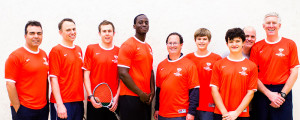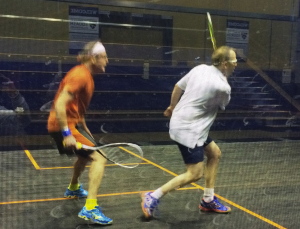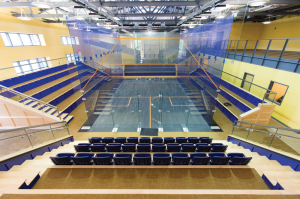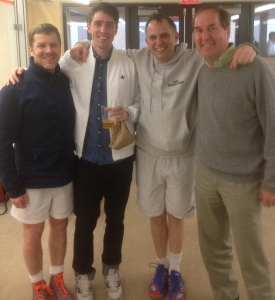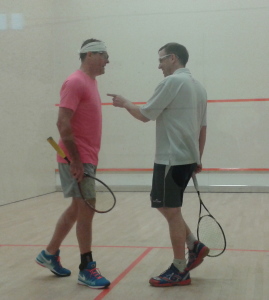Report courtesy of Joseph “Jody” Burns. Orginially published on USSquash.com.
On the morning of January 10, 2015, while playing in a singles squash match at a club on Long Island, Arvind Lall tripped over his opponent’s foot while going for a drop shot, smashed his head against the wall and broke his neck—instantly paralyzing him from the chest down.
Neurosurgeons operated on Arvind that same day, managing to repair the broken C6 & C7 vertebrae with metal pins and cleaned out most of the bone bits in the spinal canal. Although blood supply had been interrupted to the spinal cord, the good news was that the cord had not been severed. Arvind was heavily sedated for several days, inhibiting his movement and relying on a breathing tube and ventilator, and developed double pneumonia and a high fever. The doctors were able to knock out the pneumonia, but Arvind remained in the ICU for three weeks.
A friend called me the day of the accident, knowing that Arvind and I are close. My first call was to Steve Watters, a longtime friend to myself and Arvind, and headmaster at Greenvale School, where Arvind’s son, Christopher, is in the sixth grade. My second call was to John McConnell, a friend who had broken his neck in a bicycle accident in 2005.
I called John because I thought he would be able to provide Arvind and his wife, Fran, with some positive reinforcement at a very frightening time. John was originally told that he would never walk again, but went on to win a local tennis tournament a couple of years ago! What I didn’t realize when I called John was that he is also co-chair of the Christopher & Dana Reeve Foundation, dedicated to curing spinal cord injury. Through the foundation and personally, he has provided invaluable immediate guidance to Arvind and his family and has guided them to the Shepherd Center in Atlanta—the gold standard in spinal cord injury rehabilitation and recovery.
Arvind and I met playing squash in 1988 and became close friends and frequent doubles squash partners in various local tournaments over the last fifteen years. Arvind is a solo-practitioner lawyer and his wife, Fran, teaches American History at Great Neck High School. They met while students at the University of Pennsylvania: Arvind then a law student and Fran in the undergraduate program for American History.
Arvind can breathe on his own, talk, move his arms and use his hands. Now, whatever the final recovery outcome, he will not be able to work for a long time. The Lall home is undergoing extensive modifications in order to be wheel chair accessible before his return home from Shepherd later this month. In addition to a customized wheel chair, a wheel chair van and specialized home rehab equipment, he will need daily home care and rehab for the foreseeable future, if he has any hope of being able to walk, let alone stand on his own again.
Other immediate needs have been and continue to be weekly airfare for Fran and Christopher to go to Shepherd on weekends while Arvind is there. They are being trained at Shepherd now to care for Arvind once he comes home.
The Christopher & Dana Reeve Foundation estimate that the cost for Arvind’s care in the first year could be in excess of a million and a half dollars over and beyond what the family’s insurance will cover. Since Arvind will not be able to work for an indeterminate amount of time, they will be totally dependent on Fran’s salary as a teacher. Without our help, the family savings will be gone . As a squash player and friend of the family, I can’t help but feel that this is a moment for our squash community to come together to help one of our own.
Friends of the Lall family have already set up an Arvind Lall Fund donation page on the HelpHopeLive.org website. Any donation you care to make through that site will be 100% tax deductible. The immediate goal is $250,000.00 as a first step in the next sixty days.
To access the Arvind Lall Fund, go to the official page on HelpHopeLive.org. Arvind has tried to maintain a weekly blog there, as well as photos of his progress.
Arvind calls me frequently from the Shepherd Center where he undergoes many hours of exhausting daily therapy and I know he will be incredibly grateful for your help at this time of extreme need for him and his family.
HelpHopeLive’s tax ID number is: 52-1322317.
Foundations making gifts will need a W-9 form.
If you would like to help in some other way or have any questions at all, please don’t hesitate to email or call me: Joseph Burns, jburns@optonline.net, 516-528-1200.

